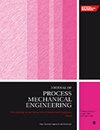A new strategy for manufacturing, modeling, and optimization of 3D printed polylactide based on multiple nonlinear neuro regression analysis and stochastic optimization methods
IF 2.2
4区 工程技术
Q2 ENGINEERING, MECHANICAL
Proceedings of the Institution of Mechanical Engineers, Part E: Journal of Process Mechanical Engineering
Pub Date : 2024-08-28
DOI:10.1177/09544089241272909
引用次数: 0
Abstract
Although there are many studies related to design, modeling, and optimization of fused deposition modeling (FDM) process parameters in the literature, the absence of a systematic approach to increase the reliability of model selection and optimization results is an important shortcoming that must be addressed. To make up for this deficiency, a new strategy was proposed to obtain desired quality on mechanical properties by adjusting FDM process parameters. This attempt involves manufacturing, modeling, and optimization point of view. The D-optimal method was employed to form experiment set, including process parameters. A hybrid approach neuro regression combining artificial neural network (ANN) and regression analysis together was used for modeling of FDM process. The most significant advantage of the neuro-regression approach compared to ANN is that the mathematical models can be used directly without needing any transformation. This is not possible in neural networks and, therefore, significantly limits and complicates the use of models obtained using ANN. The present study aims at optimization of the FDM process parameters, including infill density, infill pattern, layer thickness, and print speed on ultimate strength, fracture strength, and fracture strain for polylactide (PLA). In this regard, modified versions of the optimization algorithms Differential Evolution, Nelder Mead, and Simulated Annealing were used to find the best or elite designs. Linear or nonlinear models consisting of polynomial, trigonometric, and logarithmic expressions and their hybrid forms were employed to define the strength and strain behavior of PLA. It is concluded that (a) implementations of the optimization algorithms provide a 19% improving the minimum strain value if it is compared with the experimental results, (b) infill pattern types ( x基于多重非线性神经回归分析和随机优化方法的 3D 打印聚乳酸制造、建模和优化新策略
尽管文献中有许多与熔融沉积建模(FDM)工艺参数的设计、建模和优化相关的研究,但缺乏一种系统的方法来提高模型选择和优化结果的可靠性,这是一个必须解决的重要缺陷。为了弥补这一不足,我们提出了一种新策略,通过调整 FDM 工艺参数来获得理想的机械性能质量。这一尝试涉及制造、建模和优化三个方面。我们采用了 D-optimal 方法来形成实验集,包括工艺参数。结合人工神经网络(ANN)和回归分析的混合方法神经回归被用于 FDM 工艺建模。与人工神经网络相比,神经回归方法的最大优势在于数学模型无需任何转换即可直接使用。这在神经网络中是不可能实现的,因此极大地限制了使用 ANN 所获模型的使用并使其复杂化。本研究旨在优化 FDM 工艺参数,包括填充密度、填充图案、层厚度和打印速度对聚乳酸(PLA)极限强度、断裂强度和断裂应变的影响。在这方面,使用了差分进化、奈德米德和模拟退火等优化算法的改进版本,以找到最佳或优秀的设计。采用由多项式、三角函数和对数表达式及其混合形式组成的线性或非线性模型来定义聚乳酸的强度和应变行为。结果表明:(a) 与实验结果相比,优化算法的实施使最小应变值提高了 19%;(b) 就最大断裂强度、最小应变和最大极限抗拉强度而言,发现蜂窝状、三角形和立方体填充图案类型 ( x2) 的设计;(c) 基于 Nelder Mead 算法,可以获得许多接近最佳局部设计的断裂强度和极限强度参数。因此,这样就可以在广泛的应用领域开展工作,而不必依赖于单一的生产结果。
本文章由计算机程序翻译,如有差异,请以英文原文为准。
求助全文
约1分钟内获得全文
求助全文
来源期刊
CiteScore
3.80
自引率
16.70%
发文量
370
审稿时长
6 months
期刊介绍:
The Journal of Process Mechanical Engineering publishes high-quality, peer-reviewed papers covering a broad area of mechanical engineering activities associated with the design and operation of process equipment.

 求助内容:
求助内容: 应助结果提醒方式:
应助结果提醒方式:


